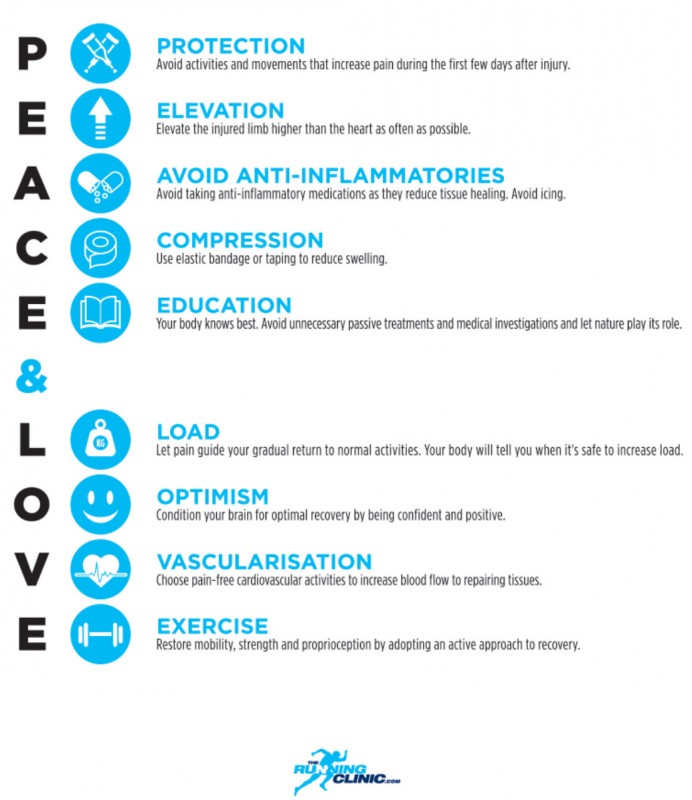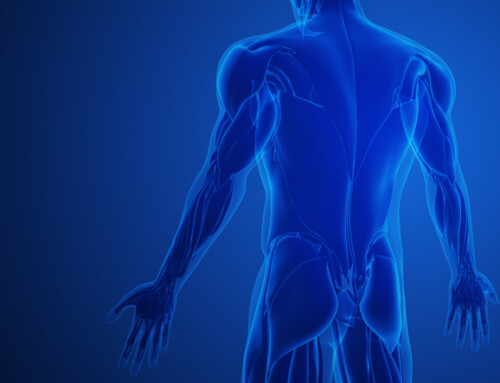by Reiko Jones, SPT
PEACE & LOVE Soft Tissue Injury Protocol
The use of the acronym PEACE and LOVE soft tissue injury protocols to facilitate soft tissue injury management will encourage early and effective treatment and optimize soft tissue recovery.
While you may have heard of RICE/PRICE (PRICE stands for Protection, Rest, Ice, Compression, Elevation) injury protocol, guidelines for injury management have continued to evolve. Dr. Mirkin, who coined RICE in 1978, retracted his ice recommendation as it may delay recovery. In 2019, a more contemporary acronym was developed by Dubois and Esculier for optimal soft tissue recovery based on current research.
Immediately After Injury

Image attribution: https://therunningclinic.com/runners/blog/archives-anglaises/peace-love-new-acronym-for-the-treatment-of-soft-tissue-injuries/
Immediately after injury it is recommended that PEACE (Protection, Elevation, Avoid anti-inflammatories, Compression, and Education) guide your approach to preventing further damage. You want to restrict/unload movement for 1-3 days to prevent further damage but want to avoid prolonged rest as it can have negative effects.
Pain signals can help guide gradual reloading. Elevate the limb above the heart, so extra fluid can flow out of the injured area. Avoid anti-inflammatory medications and ice. While ice has been found to help decrease pain, there is limited quality research on the efficacy of ice for treating soft tissue injuries, and it may disrupt tissue repair. Compress with elastic bandage or taping.
Education on active recovery should be a priority. Your physical therapist can help educate you on your condition, the healing process, load management, and appropriate activity modification to help avoid overtreatment.
After A Few Days
Once a few days have passed after the injury, LOVE (Load, Optimism, Vascularization, Exercise) is recommended to guide the management of the injury.
Optimal loading without an increase in pain can help promote repairing and remodeling tissue and build tolerance. Return to normal activities should occur as soon as symptoms allow. Research suggests realistic, positive patient expectations enhance outcomes and prognosis, while depression and fear may become a barrier to recovery.
Pain-free aerobic activity should be encouraged to increase blood flow to injury and increase motivation. Exercise helps restore strength, mobility, and proprioception and may help reduce a recurrent injury. Pain should be avoided during the subacute phase and should be utilized as a guide when increasing the difficulty of exercises.
Capital Area Physical Therapy is a leading physical therapy provider in the NY Capital Region. Contact one of our regional physical therapy clinics for more information on how PEACE & LOVE soft tissue injury protocols an provide support for soft tissue injuries.
References:
1. Mirkin, G. Why Ice Delays Recovery. September 16, 2015. Accessed April 24, 2022. https://www.drmirkin.com/fitness/why-ice-delays-recovery.html
2. Dubois B, Esculier JF. Soft-tissue injuries simply need PEACE and LOVE. Br J Sports Med. 2020 Jan;54(2):72-73. doi: 10.1136/bjsports-2019-101253. Epub 2019 Aug 3.
3. Singh DP, Barani Lonbani Z, Woodruff MA, Parker TJ, Steck R, Peake JM. Effects of Topical Icing on Inflammation, Angiogenesis, Revascularization, and Myofiber Regeneration in Skeletal Muscle Following Contusion Injury. Front Physiol. 2017 Mar 7;8:93. doi: 10.3389/fphys.2017.00093.






